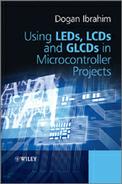Chapter 2
PIC18F Microcontrollers
PIC is a family of Harvard architecture microcontrollers (except the 32-bit devices) manufactured by Microchip Technology Inc. PIC microcontrollers are available in over 1000 models. Depending upon the data width used, we can classify these microcontrollers in three groups: 8-bit, 16-bit and 32-bit microcontrollers. Figure 2.1 shows an overview of the PIC series of microcontrollers.
Figure 2.1 PIC microcontroller series

The PIC 10, 12, 16 series are the low-end 8-bit microcontrollers with low speed, low pin count, low cost, small memories, with only 35 instructions, making them easy to learn and program. PIC18 series are medium-end 8-bit microcontrollers with medium speed, higher pin count, large memories, and having over 80 instructions. These microcontrollers include various on-chip modules, such as CAN, USB, SPI, multiple USARTs, several timers, multiplier hardware, and clock speeds up to 40 MHz. These microcontrollers are currently used in most new complex PIC microcontroller projects. PIC24 and dsPIC series are 16-bit high-speed microcontrollers with large memories and peripheral support, designed for time-critical applications where real-time processing is very important. These microcontrollers find applications in digital signal processing (DSP) and in high-speed automatic digital control systems. The architectures of these 16-bit microcontrollers are different to the 8-bit microcontrollers, as they are configured for high-speed processing required in DSP applications, having fast multiplication and addition modules (MACs).
The new PIC32 microcontroller family are 32-bit processors with standard Von Neumann architecture, having large memories and peripheral support, offering very high speed processing in highly precision applications. One of the advantages of PIC microcontrollers is that they support easy migration across product families. For example, a project designed using a PIC16 series microcontroller can easily be upgraded to use a PIC18 series microcontroller. This is especially true if the development was carried out using a high-level language such as C, which is compatible across all the 8-bit families.
Currently, most medium-speed general purpose projects with graphical display requirements are based on the PIC18F series, as they provide the required speed, large data and program memories, and large number of input-output capabilities.
PIC18 microcontrollers are available in many models, from small 18-pin chips to 100-pin chips, program memories from 4 KB to 128 KB, data memories from 256 bytes to 4 KB, and input-output pins from 15 to 70.
In this chapter we look in detail at the architecture of a medium-end PIC18 microcontroller, namely the PIC18F2410, as it will be necessary to know the basic architecture of the PIC18 series of microcontrollers when we begin creating display based projects in later chapters. The reason for choosing the PIC18F2410 is because it is a low-cost, yet powerful microcontroller, having only 28 pins, and its architecture can be considered as representative of the PIC18F series.
